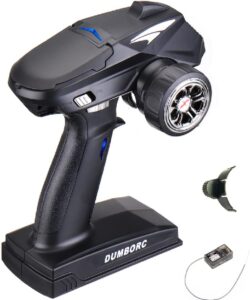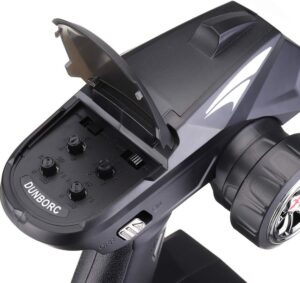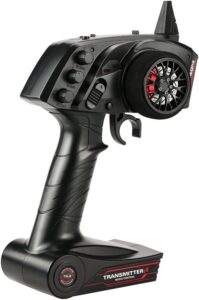The 2.4GHz radio frequency has become the ubiquitous standard for modern remote control (RC) cars and other hobbyist vehicles over the past decade, supplanting the previous 27MHz and 49MHz bands. This guide will explore the technical merits of 2.4GHz technology that have made it ideal for RC applications. We will discuss the key advantages 2.4GHz offers in terms of extended range, interference rejection, and responsiveness along with the significance of these benefits for RC car performance and competitions. The guide will also examine some limitations of 2.4GHz operation and emerging alternatives like 5.8GHz control systems.
1. What is 2.4GHz frequency
2.4GHz refers to the 2.4 gigahertz radio frequency band that is commonly used for wireless communications. It falls within the microwave portion of the electromagnetic spectrum, and has a wavelength of about 12.5 centimeters. The 2.4GHz band provides a good balance between range and bandwidth for short-range wireless devices like remote controls, cordless phones, WiFi routers, and Bluetooth devices. It offers more channels and bandwidth compared to previous lower frequencies, allowing faster data rates and improved performance. The adequate range and lack of licensing requirements also make 2.4GHz a popular choice for many radio control models and toys.
2. Why many RC cars use 2.4GHz

There are several key reasons why 2.4GHz has been widely adopted for radio control cars and other RC vehicles. Firstly, the higher frequency provides better protection against interference from other wireless sources like microwave ovens, allowing for more reliable control signal transmissions between the transmitter and receiver. Secondly, the 2.4GHz band has more available channels compared to older 27/49MHz bands, allowing multiple RC vehicles to be operated simultaneously without frequency conflicts. Additionally, 2.4GHz radios employ frequency-hopping spread spectrum (FHSS) technology which continuously switches channels to avoid static. This mitigates interruptions and results in a very responsive, glitch-free control link ideal for RC cars. Finally, the small wavelength of 2.4GHz allows for highly compact and embedded receiver circuitry. Overall, the technical advantages of 2.4GHz have made it the standard choice for hobby-grade RC vehicles looking for extended range and interference-free operation.
3. Advantages of 2.4GHz Frequency

Better interference rejection
One of the main advantages of 2.4GHz for RC applications is improved interference rejection compared to lower frequencies. 2.4GHz is less susceptible to interference from common sources like microwave ovens, Bluetooth devices, cordless phones etc, which typically operate at 900MHz to 1.9GHz. The higher frequency provides enough separation to avoid crosstalk with such devices. Additionally, 2.4GHz makes use of frequency hopping spread spectrum modulation, which continuously changes channels to avoid narrowband interference on any specific frequency. This makes the radio link very robust and resilient to external wireless signals.
Wider coverage range
The 2.4GHz band also provides moderately better range compared to 900MHz or 1.2GHz bands previously used for RC. The shorter 2.4GHz wavelength enables smaller antenna designs that concentrate more radiated power into directional propagation patterns. This allows 2.4GHz RC systems to achieve ranges of up to 500m or more, adequate for most RC vehicle use cases. Walls and obstacles have less of an impact compared to lower frequencies. The higher immunity to interference also indirectly improves effective range by reducing dropouts.
Higher frequency allows faster response
The high carrier frequency of 2.4GHz has less inherent latency compared to the lower legacy bands. The higher bandwidth enables faster digital modulation speeds for real-time telemetry and video transmission from RC models. This allows for lower control loop delays between the pilot’s transmitter inputs and model reactions. Coupled with modern protocols like FHSS that minimize transmission errors, 2.4GHz provides very responsive control essential for high performance RC use. The high update rates and lack of lag time gives pilots a sense of direct connection to the vehicle.
4. Significance of 2.4GHz for RC Cars

Increases control distance and reliability
The excellent interference rejection and range benefits of 2.4GHz allow RC cars and trucks to be controlled at much greater distances compared to old 27/49MHz systems. This increased operating range gives more flexibility in terms of maneuvering space and course layout options. The very reliable signal link provided by 2.4GHz and FHSS helps eliminate frustrating mid-race cutouts and gives drivers confidence to push their RC vehicles to the limit during competitive events. The stability of 2.4GHz against interference and dropout makes it ideal for serious RC racers and hobbyists looking for top-tier performance.
Allows more cars to run simultaneously
The larger channel capacity of 2.4GHz is a major factor enabling multiple RC cars to operate together without frequency conflicts. Older narrowband systems were limited to just 1 or 2 simultaneous vehicles. Modern 2.4GHz radios have anywhere from 50 to hundreds of channels for frequency hopping routines, allowing large groups of racers to run together. Tracks and race organizations can support bigger events and more entrants with 2.4GHz. This has made the hobby more accessible and competitive.
Frequency hopping avoids interference
A defining feature of 2.4GHz RC systems is the use of FHSS technology to continuously change channels during operation. This prevents static or radio congestion on any specific frequency from blocking the signal. Interference on one channel is simply skipped over once the system hops to a new clean channel. FHSS coupled with 2.4GHz provides an added layer of interference protection to maintain a reliable control link in noisy environments with many wireless signals. This is crucial for busy tracks and race venues.
5. Disadvantages of 2.4GHz and Alternatives

Susceptible to environmental factors
While 2.4GHz is a major improvement over older RC radio systems, it still has some limitations. The higher frequency means 2.4GHz is more sensitive to moisture absorption and signal reflection off surfaces compared to lower bands. This can lead to degraded range and multipath interference near bodies of water or around dense vegetation and certain materials. Reflections off the ground tend to be stronger at 2.4GHz as well. Care must be taken to use high quality coaxial cabling and well-designed antennas to counteract these environmental impacts.
5.8GHz band also being adopted
To further advance RC radio performance, some newer systems are migrating to 5.8GHz operation. At nearly twice the frequency, 5.8GHz has even wider bandwidth potential along with reduced interference and better diversity against signal fade. Being less common than 2.4GHz, 5.8GHz is less crowded and constrained. However the tradeoff is slightly shorter range due to higher attenuation. New RC models aimed at first-person-view (FPV) racing are leading the way in adopting 5.8GHz control and video transmission for ultralow latency. But 2.4GHz remains very popular for its balance of range, interference resilience and adequate performance for most users.
Frequently Asked Questions about 2.4GHz for RC cars
What is 2.4GHz and why is it commonly used for RC cars?
2.4GHz refers to the 2.4 gigahertz radio frequency band. It provides a good blend of range, interference resistance, and bandwidth for RC applications. The adequate range of 2.4GHz allows RC cars to be operated at medium to long distances. It also offers good interference rejection from common sources like WiFi, Bluetooth, and microwave ovens that operate near the 2.4GHz spectrum. This prevents signal dropout and loss of control. Finally, the high bandwidth enables low latency controls and real-time telemetry for a responsive RC experience.
How does 2.4GHz provide better interference resistance than older RC frequencies?
2.4GHz has some key advantages compared to older 27MHz or 49MHz RC systems when it comes to interference immunity. Firstly, it has more channel options, often using frequency hopping spread spectrum (FHSS) across 50+ channels to avoid static or congestion problems on a single frequency. Additionally, the higher frequency separation from most interference sources gives greater rejection of unwanted signals. And the short wavelength allows for directional antennas that focus energy for a stronger intended signal between the transmitter and car.
What is frequency hopping and how does it help 2.4GHz RC cars?
Frequency hopping spread spectrum (FHSS) is a technique 2.4GHz RC radios use to rapidly switch channels during operation. This prevents any single narrowband interference source from blocking the signal continuously. The transmitter and receiver hop across clear channels avoiding static, allowing for an uninterrupted control link. FHSS coupled with the many channel options of 2.4GHz results in extremely reliable signal connections.
How has 2.4GHz changed RC car racing competitions?
The use of 2.4GHz control systems has been a game-changer for RC racing events. Racers can drive much farther out on courses without signal dropouts. The resistance to interference also provides confidence during critical maneuvers in close proximity with other cars. Additionally, support for multiple racers simultaneously without frequency conflicts has enabled larger scale organized races at dedicated tracks. This has made the hobby more competitive, popular and welcoming to new enthusiasts.
What are the downsides of using 2.4GHz for RC cars?
2.4GHz is more sensitive to moisture and reflective materials than lower bands, which can potentially limit range in certain environments. Reflections off the ground also induce multi-path interference in some cases. Additionally, 2.4GHz is becoming crowded in urban areas saturated with many wireless devices using this spectrum. Newer bands like 5.8GHz aim to overcome these constraints while building upon the advantages of 2.4GHz technology.
Final Thoughts
In conclusion, the adoption of 2.4GHz control systems has proven transformative for RC vehicles. The combination of robust interference rejection, adequate range, and fast response enabled by 2.4GHz technology has allowed RC cars to achieve impressive performance levels that simply were not possible with older radio systems. Hobbyists can now operate their vehicles at longer distances and in crowded environments that induce wireless interference. The capacity of 2.4GHz to support multiple simultaneous RC models has also made larger scale races possible and helped grow the hobby. While it has some downsides, 2.4GHz delivers an ideal balance of reliability, latency, range and versatility. This has firmly established 2.4GHz as the standard control frequency, ushering in a new era of capability and popularity for RC racers and hobbyists alike. As technology continues advancing, we may see emerging bands like 5.8GHz complement or supersede 2.4GHz, but its impact will remain profound.
Enjoyed this guide of What Does 2.4GHz Mean for RC Cars? Then be sure to check out our other RC Rating guides.